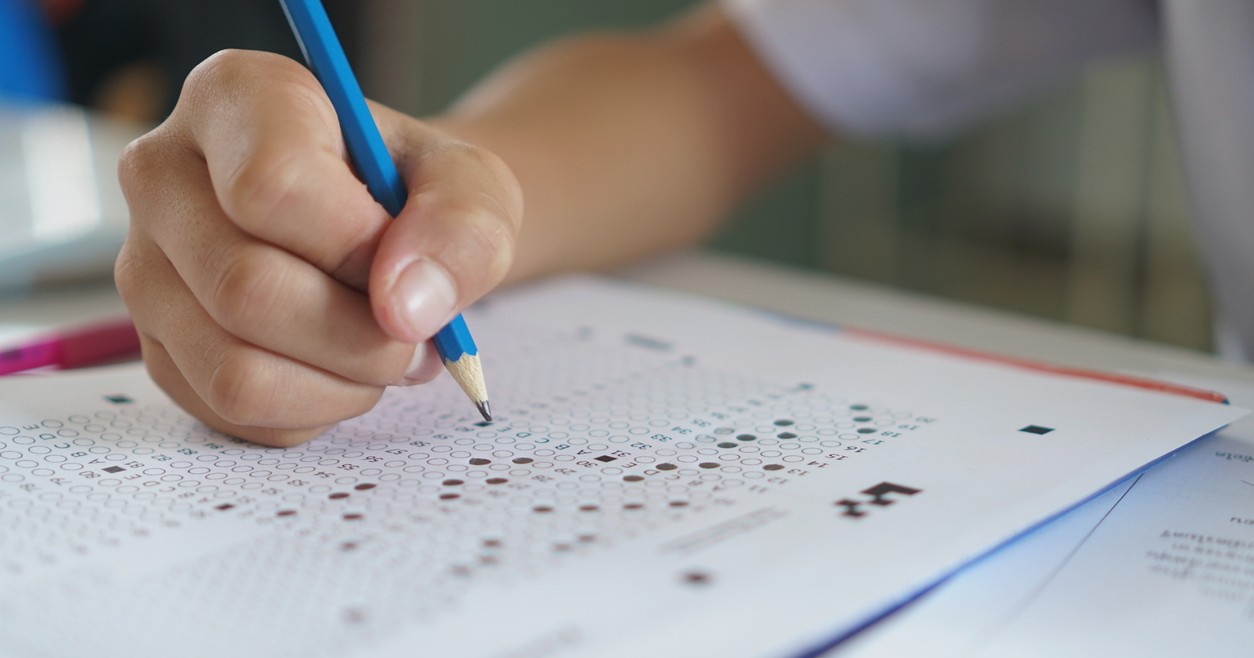
“The purpose of this title is to ensure that all children have a fair, equal, and significant opportunity to obtain a high-quality education and reach, at a minimum, proficiency on challenging State academic achievement standards and state academic assessments.”
Standardized testing is a staple of American education. With roots dating back to the 19th century, standardized testing began to be used nationally by the 1980s.
The No Child Left Behind Act of 2001 mandated annual testing in all 50 states, propelling the use of the tests into overdrive. From elementary school to college and university admission, standardized testing is the “gold standard” for student assessment nationwide. However, it has recently come under serious scrutiny.
Advocates of standardized testing offer convincing arguments. For instance, the tests provide an objective method of evaluating educational progress.
“What better way to prove you’ve learned something than to perform a task based on that learning? That’s the theory behind performance-based assessment, which asks students to … solve a problem or complete a task applying what they’ve learned throughout the school year,” notes Funderstanding, “Fans of this type of assessment say it’s much closer to how students will be assessed in the ‘real world,’ and it’s also a great way to foster a sense of innovation and problem-solving that’s lost in the land of the standardized test.”
Critics of these tests point to numerous objections, such as the unfair advantage standardized tests give to children who are naturally good at taking tests. Students who struggle in this area are at an automatic disadvantage. Additionally, these assessments may not offer a reliable measurement of student progress.
There is no doubt that standardized tests are entrenched in modern American education, with their pros and cons. This article will examine standardized testing as a whole and take a deeper dive into just a few of the many arguments for standardized testing.
Standardized Testing Defined
Standardized testing is a general method of testing students to collect data and evaluate academic advancement. According to The Glossary of Education Reform, “A standardized test is any form of test that (1) requires all test takers to answer the same questions, or a selection of questions from common bank of questions, in the same way, and that (2) is scored in a “standard” or consistent manner, which makes it possible to compare the relative performance of individual students or groups of students.”
In general, the term “standardized test” refers to large-scale tests administered within the education system. These tests target large populations of students and often use multiple-choice and true-false formats. Standardized tests are not comprehensive, and they are not designed to be. Instead, they are used to offer insights and data.
Education Post notes, “Standardized tests are a spotlight that helps education leaders see what effect schools are having on students. With that information, they can make changes to address students’ needs. Like any spotlight, state tests cannot shed light on the entire scene, but they can illuminate some of the trouble spots and positive signs along the path to providing a better education.”
Benefits of Standardized Testing
1. It is Uniform
Educational policymakers tout a host of reasons in support of large-scale standardized testing. One pro is that the tests are uniform; all students are given the same opportunity since the tests are the same across the board.
“Standardized tests are carefully constructed tests that have uniformity of procedure in scoring, administering, and interpreting the test results,” states Honest Pros and Cons. “All students are provided with the same tests and scored consistently, in a standard manner, to make it possible to compare the results of individual tests as a performance standard.”
The fact that the tests are standardized for all participating students offers a sense of fairness and accountability.
2. It Allows for Comparisons and Accountability
Since standardized testing is exactly that—standard—it can offer a level of statistical comparison and accountability across districts and regions. Despite any perceived (or actual) shortcomings of the tests, the fact of the matter is that their uniformity provides the same advantages and disadvantages from community to community. This allows for performance and data comparison.
Vittana.org explains, “The information that is provided by a standardized test allows parents to see how their children are performing against national standards through a percentile rating … Every student is evaluated in the same way with these tests, which means there is a guarantee of a specific educational framework in every school.”
Standardized tests offer a baseline of assessment and help to evaluate school standards. ThoughtCo notes that a significant benefit of standardized testing is that educators are held responsible for teaching students the required material. Because test scores become public record, teachers and schools that appear to be failing their students can be examined and held accountable.
Standardized testing can be a helpful tool and has the ability to provide unique data nationwide. When analyzed correctly, this is a definite pro for standardized testing.
3. It Charts Individual Progress
“Standardized testing can also help standardize individual students’ educations,” suggests Spark Admissions. “In addition to comparing students against one another or identifying problematic schools or districts, standardized tests can also illustrate student progress over time. Taking the same or similar tests over the years can allow students to indicate measurable improvement.”
Standardized testing is conducted fairly frequently for most students. According to a comprehensive study conducted by the Council of the Great City Schools, students took an average of 112 mandatory standardized tests between pre-K and 12th grade. This results in plenty of individualized data to map each student’s progress throughout his or her school experience.
Standardized tests can also be used to evaluate whether or not a student is eligible to advance to the next grade. While it’s fairly common for students to move on to the next grade with their peers, versus being held back, this is a highly debated practice. Teachers and parents can use standardized testing results to help determine whether a child should be held back or not.
VitaEducation notes this as a pro, “State-mandated standardized tests help prevent ‘social promotion,’ the practice of allowing students to advance from grade to grade whether or not they have met the academic standards of their grade level. A Dec. 2004 paper by the Manhattan Institute for Policy Research found Florida’s 2002 initiative to end social promotion, holding back students who failed year-end standardized tests, improved those students’ scores by 9% in math and 4% in reading after one year.”
Standardized testing can paint teachers, parents, and the students themselves a valuable and personalized picture of each child’s abilities and knowledge.
4. It Spans Educational Options
Because the tests are nationally uniform, they can span educational options. There are several alternatives to public education. Time4Learning offers a brief look into other educational options, including homeschooling and private schools.
Standardized testing can be a valuable tool for parents, teachers, and students outside of the public school platform. Below is an overview of standardized testing in the homeschool and private school arenas:
Homeschooling
For instance, homeschooled children have the opportunity to test their knowledge and abilities against other students nationwide.
Standardized tests appeal to many home educators who want to help their children stay “up to par” or at an appropriate stage for their grade level. Standardized testing can offer an objective glance at how these children measure up to national averages. Additionally, the tests can provide homeschooling families with a degree of protection and validation for their education choice.
The Homeschool Legal Defense Association offers an excellent explanation of the pros and cons of standardized testing for homeschooled students. They note these specific “pros”:
-
It is the most objective form of academic assessment.
-
It is well recognized by academic institutions. If your child reenters the traditional school setting after being homeschooled, having some well-recognized test scores may ease the process.
-
If you need, or want, to know what grade level your child is in based on content knowledge, then these tests can be more helpful than specific-subject placement tests.
Quote taken from “Intro to Standardized Testing.”
Private Schooling
Standardized testing in private schools can be a bit of a complex issue. Study.com explains, “The regulations governing private schools vary widely from state to state. Some states, like South Dakota, require private schools to use the same tests that are used in the public system. Others, like Wisconsin, offer the public school tests as an option for private schools. There are also states, like South Carolina, which have no policy in effect at all. Finally, states like California explicitly ban the use of public testing resources by private schools.”
While many private schools do not use standardized testing, some do, either by choice or by law. Generally, private schools do not publish the testing score data, which is one difference between their testing protocol and those of public schools. However, the test results can offer many of the same benefits for private school parents, students, and teachers as they do for public schools.
To summarize, standardized testing allows for evaluation and assessment beyond the conventional classroom. This offers an equal opportunity for all educational backgrounds to enjoy the same testing benefits and data interpretation.
Pros Summarized
Standardized testing is a widely-debated topic, with many angles to consider. This article has examined a number of proclaimed benefits of this method of evaluation:
- It’s uniform
- It allows for comparison and accountability
- It charts individual progress
- It spans educational options
While there are plenty of advocates for standardized testing, many do not hold the same positive views. Stay tuned for the second half of this discussion! Our follow-up article will examine what critics have to say about the cons of standardized testing.
“Standardized tests don’t care if you’re white or black, short or tall, or even the rate at which you learned the course material. At the end of the day, all it cares about is whether you know what you’re supposed to know. It can’t be cheated, bent, or bargained with.”
Did you know this is the first part in a series on the pros and cons of testing? Read part 2 here.





[…] This peek into the positive side of standardized testing can be found here. […]
[…] of how you feel? Learn more about the pros and cons of standardized testing, and let us know what you […]
[…] the growing issue of “teaching to the test.” Since the No Child Left Behind Act was passed, standardized testing has become…well, a standard. These tests play a big part in determining which schools and […]
[…] the days of the standardized test numbered? Read up on why advocates want to keep standardized testing around and let us know what you […]
[…] Read more: The Pros and Cons of Standardized Testing […]
[…] Pros & Cons of Standardized Testing (& Part 2) […]
[…] Read more: The Pros and Cons of Standardized Testing […]